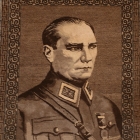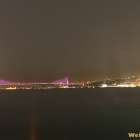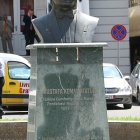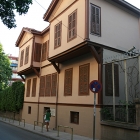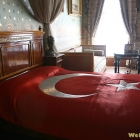Mustafa Kemal Ataturk, one of the greatest political leaders of 20th century
The closest character to Ataturk is probably Napoleon Bonaparte: a military man with great achievements on the battle field, a reformer involved in every aspect of life, with a legacy that lives to this day. Ataturk had only 15 years of political power to transform a decadent empire, attacked by all its neighbors and their allies, into a modern country. He started the industrialization of the country and revitalized the economy during The Great Depression, inspiring enthusiasm and ambition to a population with a 92% rate of illiteracy. The cultural and religious changes started by Ataturk are impressively vast: he even changed the alphabet in very short time, an endeavor that even Peter The Great did not dare, during his reforms in Russia.
The first president of Turkey had a special name from his birth: Mustafa (“The Chosen One“). The other two names were added later in life by those who met him. In military school he got the name Kemal (“Perfect“). And when he imposed the European custom of having surnames to a former tribal society, he adopted the family name the people already gave him: Ataturk (“Father of the Turks“).
I followed the footsteps of this great man, from the house where he was born, in Thessaloniki, to the streets of Istanbul, to the place where he passed away.
Mustafa Kemal was born in Salonika, a city that was then part of the Ottoman Empire. The former Byzantine city (now, Thessaloniki, Greece) was a cosmopolitan place, with a majority of Jewish population, Greeks, Turks and all other nations of the Balkans. It was very hard for me to find the house of Ataturk in today’s Thessaloniki. Given the animosities between the two neighbors, what is now the Turkish consulate and the Ataturk museum is not signaled in any way, and you hardly find a local to guide you to the house covered by ivy and hidden behind a high fence.
Thessaloniki is very close to Pella, the place of birth for Alexander the Great and for his father, Philip II, from whom he inherited the Macedonian empire. It’s a story that probably impressed the young Mustafa, whose childhood was marked by the premature loss of his father when he was seven. His mother, a religious person, wanted for him a career as a clergyman, but had to accept her son vocation.
But as the Ottoman Empire was a Caliphate (a theocracy), even the military school of that time was influenced by the monopoly on knowledge held by Islamic scholars. The courses of young officers would stop five times a day, to respect the prayers prescribed in the Qur’an and Western information was filtered and scarce. What was once the great Ottoman Empire, spreading from Asia, to Europe and Africa, the empire that conquered Constantinople and only stopped at the gates of Vienna, was now in ruin, named the “sick man of Europe”, in political circles.
The bureaucracy of the Sultan was eaten by corruption and plots, the rural population living in ignorance and the primitive economy incapable to finance an army powerful enough to maintain the conquered territory. Renaissance, the American and French revolutions, the industrial revolution and all the phenomenas that shaped the Western modernity had only shallow echoes in an empire that maintained a medieval political system and had areas where people lived in prehistoric conditions.
This lead, well before Ataturk, to a movement inside the elite that was favorable to change. A constitution was briefly adopted by the sultan, and public, as well as secret movements started to emerge, such as the Committee of Union and Progress and The Young Turks. A reader of Voltaire and Rousseau, Ataturk was conquered by the ideas of Enlightenment and of turning the Ottoman Empire into a constitutional monarchy. He joined a masonic-like secret organization called “Motherland and Freedom” and had a minor role in the Young Turks revolution. The reforms promoted by the progressive movement of the Young Turks failed to bring the expected transformation, and corruption maintained at a high level.
After publishing some articles favorable to the Young Turks movement, Ataturk is shortly arrested and detached to the remote Damascus. The Balkan wars and the first world war brought up his remarkable military qualities. Ataturk was the only Ottoman military commander that was undefeated during world war 1. Famous battles include Gallipoli, the resistance against the British navy or battles with the Russian army.
The overall outcome of the first world war was a disaster for the Ottoman Empire, who fought aside Germany and Italy against the Allies, who decided to divide the empire. The Eastern part of the Ottoman Empire gave birth later to the national states of the Arab world such as Syria, Lebanon, Palestine, Saudi Arabia, under the mandate of France and Great Britain. The heartland of the Ottoman Empire, Anatolia, the Bosphorus and Dardanelles straits and Istanbul were craved by all important allied nations. With Istanbul occupied, the sultan accepted the claims of the allies and appointed Atatürk among the officers who were to oversee the demobilization of the Ottoman army.
Ataturk did the exact opposite and, like general De Gaulle later in France, organized a resistance movement. When the British dissolved the Ottoman Parliament, Ataturk created the Grand National Assembly, which from this moment on was to replace the Parliament. As Istanbul was occupied, Ataturk chose the Anatolian Ankara as his new capital. His victories during the Independence war made him a legendary figure among the Turks, which from this moment on will completely fall under his spell. The battles won by Ataturk’s army, who managed to drive the Greeks, French, British and Armenians out of the Turkish land, forced the allies to renegotiate the peace terms.
After obtaining peace and independence, Ataturk proclaimed republic and started a series of reforms at an amazing scale. The most important and delicate one was the abolition of the Caliphate, that turned Turkey into a secular state. For the first time children could study in schools that were independent of Islamic scholars, women received the right to vote, even before this was gained in other Western countries. The Turks were persuaded and sometimes forced to give up their traditional Oriental garments in favor of European costumes and hats. Traditional costumes that had a religious significance tied to them were forbidden to those outside the Muslim priesthood. Such an ambition of changing the popular culture of a nation remembers the reforms of Peter the Great in Russia, the Tsar who forcibly cut down the beards of the Russian peasants.
In reforming the educational system, Ataturk was advised by one of the fathers of American pragmatism, John Dewey. The most dramatic educational reform brought the abandonment of Arabic alphabet and the adoption of the Latin alphabet, with some specific letters. The entire population had to learn the new alphabet (easier than the Arab one) or learn to read and write for the first time. A similar massive action of educating the masses was carried out in newly communist Russia at Lenin’s initiative.
A new translation of the Qur’an was promoted. Until then, the Arabic text was considered too sacred to be translated, so it was often memorized and seldom understood by peasants. Such an initiative was practically a repetition of Martin Luther’s Reform done half of millennium ago in the Catholic world. Many religious sites were turned into museums, as was the case of the church of Hagia Sophia, that had been turned into a mosque after the conquest of Constantinople.
The absolute power held by Ataturk from the moment he proclaimed the republic in 1923, to the moment of his death, lead to controversies over his democratic convictions. But Ataturk always put his ideals above his immediate goals. After winning the independence war, he refused the position of Caliph, that would make him a religious leader and an absolute monarch. One of his greatest merits is the refusal of both the totalitarian approaches, in an era when it seemed that communism or fascism might be shortcuts to development. His attempt to adapt the Western democracy to the Turkish realities of his time confused his more famous contemporaries: Hitler called him a communist, Stalin thought he was a fascist, while Roosevelt said he was told that this was the greatest leader of Europe of his time.
Amazingly, Ataturk fought some of his most important battles against the Western powers that inspired him intellectually (the British and the French), and did not live enough to see a significant help from United States and other Western countries that would later come to consider Turkey as part of their political civilization. Moreover, Ataturk’s regime developed the banking system, extensive agriculture and industry plants in a period marked worldwide by the Great Depression.
Most of the time, the system created by Ataturk had only one party, without being a totalitarian one. Ataturk encouraged the creation of other parties, but when they challenged his secular reforms, he suppressed them, even with a rare episode of political purging. This must be understood as a commitment to a constitutional system that defends fundamental values, sometimes by brute force, as in a country with over 98% of Muslim population and 8% literacy rate (at the time) people could easily fall into the hands of populists who might use religious rhetoric to serve their own personal interests.
The realistic way in which Western democracy was adapted to post-Ottoman realities was probably the key to the long term survival of Kemalist reforms even after the death of its political founder. In Germany, a society with parliamentarian traditions, the Nazis were able to take power democratically, by speculating the weaknesses of a democracy without substance. In Iran, the Shah, an admirer of Ataturk tried to emulate his reform in an even more Oriental society. After decades of significant progress and some corrupt successors, the Iranian people turned away from this path in the 1970s and adopted an even more aggressive form of Islamic fundamentalism after the Iranian Revolution. In Turkey, on the other hand, the myth of Ataturk and the institutions he created survive to this day and despite recent reawaken of fundamentalist feelings, the country is a long time member of NATO, a candidate at joining the European Union and a vivid democracy.
The six pillars of Ataturk’s original ideology must be explained and understood in their context. The secularism, for instance, was not aimed against religion, that would have to gain from not being used anymore in political disputes. The republicanism refers to a constitutional system governed by the rule of law. The same, the expressed populism must not be mistaken as the Western synonym for demagogy. It was meant to express the involvement of the people in political decisions. Revolutionism referred to the dramatic changes that were meant to be irreversible and done at a quick pace. Statism was viewed as a development method that involved the state in a capitalist economy that respected private property and entrepreneurship, to produce wealth especially in the vast projects that were unattainable to a society that didn’t yet escape poverty. Finally, nationalism was a way of building an identity to a people of diverse ethnic origins after the fall of the Ottoman Empire, and did not imply the intolerance and xenophobic reactions associated with this term in modern times. It was about building a society on civic, not on ethnic terms.
In his private life, Ataturk was not as successful as in his public life. The woman with whom he had a long relationship committed suicide after being left for another woman. After their divorce, his wife lived a secluded life until her death. Ataturk lived up to his name of “father of the Turks” by adopting no less than 13 children (among which a single boy). After his death, Ataturk left all his wealth to the Turkish state.
Ataturk died prematurely due to continuous stress, long hours of work and heavy drinking, in an apartment of the Dolmabahce Palace. The clock in that room is stopped at the hour Ataturk passed away. Visitors of the Harem section of Dolmabahce can even see the bed on which Ataturk died, now covered in a silk Turkish flag sewed with silver and gold.
Statues of him have been raised allover Turkey, the largest bridge in Istanbul, the international airport and other monuments bear his name, while in Ankara a mausoleum was built. In Turkey, the mythical figure of Ataturk is revered with almost religious deference. A law, similar to that against Holocaust denial, was passed out forbidding any materials that would offend the memory of the Father of modern Turkey.
In Bucharest there is a bust for Ataturk in front of Odeon Theatre on Calea Victoriei, the most important boulevard in the city.
- Home Page
start page - Architecture
landmark buildings - Sacred architecture
places of worship - Nature
landscape photography - Concert
performing artists - Christmas
Santa Claus pictures
- Jooble
jobs for photographers - Escape
an out of control blog - Merry Christmas
The best organizer of Christmas parties - Astro photo
Eclipse hunting and astrological photography

